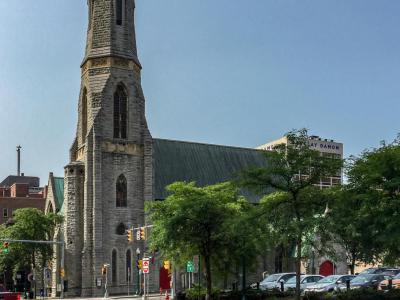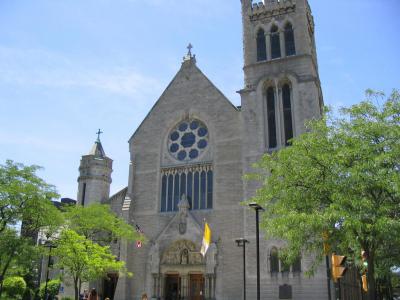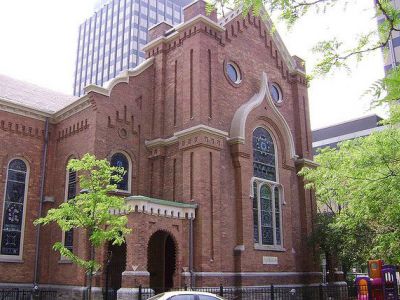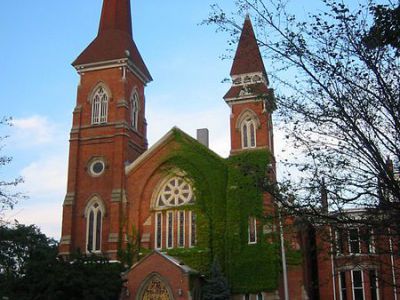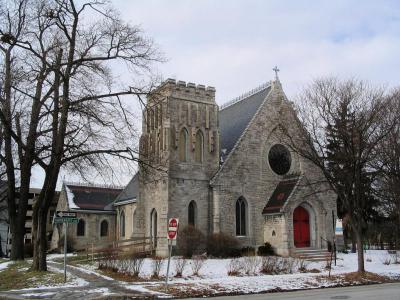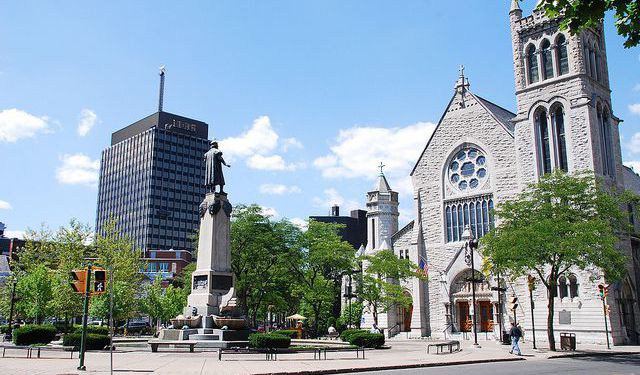Historical Churches Walking Tour (Self Guided), Syracuse
Syracuse, NY is a melting pot of religious traditions and beliefs, which is evident in the local religious architecture. Most Christians in the city are Catholic, reflecting the influence of 19th and early 20th-century immigration patterns, when numerous Irish, German, Italian and eastern European settlers. Other than Catholic, there are dozens of other churches in the city, including Eastern Orthodox, Jehovah's Witness, Christian Science, Reformed Presbyterian, and Metaphysical Christian. Some of these are quite notable in terms of architectural and historical heritage. Here are the most prominent ones.
The Cathedral of the Immaculate Conception – consecrated in 1910, it features the Shrine of the Blessed Mother with a statue sculpted by LeMoyne College Professor Jacqueline Belfort-Chalat.
Another major historic temple in Syracuse is the Episcopal St. Paul's Cathedral, a Gothic-style edifice built in the early 1800s, added to the National Register of Historic Places on December 1, 1978.
Plymouth Congregational Church – designed in 1858 by Horatio Nelson White in the Romanesque Revival style. Its founding congregation was closely associated with the abolitionist movement in Syracuse. The church was listed on the National Register of Historic Places on November 7, 1997.
Grace Episcopal Church – a historic Episcopal parish founded in 1871. This Gothic Revival building was also designed by Horatio Nelson White and was constructed in 1876. The church has a long history of social activism. In the late 1900s, David Pendleton Oakerhater, a Cheyenne warrior and political prisoner was baptized and ordained here. On March 20, 1973, the building was listed on the National Register of Historic Places.
To learn more about these and other impressive churches and cathedrals of Syracuse, NY, take this self-guided walking tour.
The Cathedral of the Immaculate Conception – consecrated in 1910, it features the Shrine of the Blessed Mother with a statue sculpted by LeMoyne College Professor Jacqueline Belfort-Chalat.
Another major historic temple in Syracuse is the Episcopal St. Paul's Cathedral, a Gothic-style edifice built in the early 1800s, added to the National Register of Historic Places on December 1, 1978.
Plymouth Congregational Church – designed in 1858 by Horatio Nelson White in the Romanesque Revival style. Its founding congregation was closely associated with the abolitionist movement in Syracuse. The church was listed on the National Register of Historic Places on November 7, 1997.
Grace Episcopal Church – a historic Episcopal parish founded in 1871. This Gothic Revival building was also designed by Horatio Nelson White and was constructed in 1876. The church has a long history of social activism. In the late 1900s, David Pendleton Oakerhater, a Cheyenne warrior and political prisoner was baptized and ordained here. On March 20, 1973, the building was listed on the National Register of Historic Places.
To learn more about these and other impressive churches and cathedrals of Syracuse, NY, take this self-guided walking tour.
How it works: Download the app "GPSmyCity: Walks in 1K+ Cities" from Apple App Store or Google Play Store to your mobile phone or tablet. The app turns your mobile device into a personal tour guide and its built-in GPS navigation functions guide you from one tour stop to next. The app works offline, so no data plan is needed when traveling abroad.
Historical Churches Walking Tour Map
Guide Name: Historical Churches Walking Tour
Guide Location: USA » Syracuse (See other walking tours in Syracuse)
Guide Type: Self-guided Walking Tour (Sightseeing)
# of Attractions: 5
Tour Duration: 1 Hour(s)
Travel Distance: 2.0 Km or 1.2 Miles
Author: DanaOffice
Sight(s) Featured in This Guide:
Guide Location: USA » Syracuse (See other walking tours in Syracuse)
Guide Type: Self-guided Walking Tour (Sightseeing)
# of Attractions: 5
Tour Duration: 1 Hour(s)
Travel Distance: 2.0 Km or 1.2 Miles
Author: DanaOffice
Sight(s) Featured in This Guide:
- St. Paul's Cathedral
- Cathedral of the Immaculate Conception
- Plymouth Congregational Church
- Park Central Presbyterian Church
- Grace Episcopal Church
1) St. Paul's Cathedral
Saint Paul’s Cathedral in Syracuse stands as both a spiritual landmark and a symbol of the city’s evolution from a canal town to an urban center. Established in the 1820s, its origins are rooted in the rapid expansion sparked by the Erie Canal. What began with worship in a tavern grew into a robust Episcopal congregation, ultimately meriting the creation of a new diocese in 1868. The present Gothic Revival church, completed in 1884, was designed by Henry Dudley using locally quarried limestone. Its 225-foot spire, added in 1907, continues to define the Syracuse skyline.
The White family played an instrumental role in shaping Saint Paul’s history. Banker and businessman Horace White served as a longtime vestryman and is honored with a stained glass window. His wife, Clara Dickson White, funded the church tower, and the spire bears her dedication. Their sons, Andrew Dickson White-co-founder of Cornell University-and Horace Keep White, commemorated their parents with the 1907 spire and memorial chancel window, honoring the family's deep legacy.
Beyond its historical and architectural stature, Saint Paul’s Cathedral fosters an inclusive and socially engaged community. From soup lunches for downtown workers to worship services in Dinka for South Sudanese refugees, the church embraces diversity in every form-political, economic, and spiritual. Programs like the Adult Relationship Day initiative and the free children's summer camp further reflect its mission to cultivate connection, compassion, and dignity.
Located on Montgomery Street, Saint Paul’s is more than the seat of the Diocese of Central New York-it is a place of worship, refuge, and vibrant civic life open to all.
The White family played an instrumental role in shaping Saint Paul’s history. Banker and businessman Horace White served as a longtime vestryman and is honored with a stained glass window. His wife, Clara Dickson White, funded the church tower, and the spire bears her dedication. Their sons, Andrew Dickson White-co-founder of Cornell University-and Horace Keep White, commemorated their parents with the 1907 spire and memorial chancel window, honoring the family's deep legacy.
Beyond its historical and architectural stature, Saint Paul’s Cathedral fosters an inclusive and socially engaged community. From soup lunches for downtown workers to worship services in Dinka for South Sudanese refugees, the church embraces diversity in every form-political, economic, and spiritual. Programs like the Adult Relationship Day initiative and the free children's summer camp further reflect its mission to cultivate connection, compassion, and dignity.
Located on Montgomery Street, Saint Paul’s is more than the seat of the Diocese of Central New York-it is a place of worship, refuge, and vibrant civic life open to all.
2) Cathedral of the Immaculate Conception
The Cathedral of the Immaculate Conception dates to 1910. One of the church's most beloved highlights is its Shrine of the Blessed Mother. The statue's artist is Jacqueline Belfort-Chalat, a professor at LeMoyne College. This area is a popular place for visitors to pray in the cathedral, along with the area near the Sacred Heart Altar.
Besides being a popular place for prayer and reflection, the area near the Sacred Heart Altar is host to another important piece of art. This area features a mosaic in honor of Saint Marianne Cope, a Franciscan sister from central New York. The saint became known for ministering to a colony of lepers in Hawaii.
Concerts and musicals are regular events here, in addition to the daily Masses. Local colleges and high schools make up some of the most frequent performers. Professional groups have also performed at the cathedral because of its excellent acoustics.
Besides being a popular place for prayer and reflection, the area near the Sacred Heart Altar is host to another important piece of art. This area features a mosaic in honor of Saint Marianne Cope, a Franciscan sister from central New York. The saint became known for ministering to a colony of lepers in Hawaii.
Concerts and musicals are regular events here, in addition to the daily Masses. Local colleges and high schools make up some of the most frequent performers. Professional groups have also performed at the cathedral because of its excellent acoustics.
3) Plymouth Congregational Church
Plymouth Congregational Church, located on East Onondaga Street in Syracuse, was founded in 1853 by a group of abolitionists committed to fighting slavery and promoting justice. The church quickly became a key player in the city's abolitionist movement, hosting antislavery figures such as Frederick Douglass and possibly serving as a stop on the Underground Railroad. Its striking Romanesque Revival architecture, designed by Horatio Nelson White, was completed in 1859, with a major redesign overseen by White in 1870-1871. The church was listed on the National Register of Historic Places in 1997, not only for its architectural beauty but also for its historical significance in the fight for human rights.
A hallmark of Plymouth Congregational Church is its deep commitment to social justice. Over the years, it has championed various causes, including women's rights, immigrant rights, LGBTQ+ rights, and the fight against racism and poverty. The congregation continues this activism into the present day, living out its faith through initiatives like a community food pantry that supports those in need. Plymouth prides itself on being an inclusive, welcoming space where all are encouraged to grow in faith, embody compassion, and work toward justice and peace.
The church is also home to a remarkable 3,000-pipe Möller organ, installed in 1930, and boasts beautiful stained-glass windows dating from 1859 and 1871. Its legacy of activism, inclusivity, and beauty makes it a cornerstone of both the local community and the broader justice movement.
A hallmark of Plymouth Congregational Church is its deep commitment to social justice. Over the years, it has championed various causes, including women's rights, immigrant rights, LGBTQ+ rights, and the fight against racism and poverty. The congregation continues this activism into the present day, living out its faith through initiatives like a community food pantry that supports those in need. Plymouth prides itself on being an inclusive, welcoming space where all are encouraged to grow in faith, embody compassion, and work toward justice and peace.
The church is also home to a remarkable 3,000-pipe Möller organ, installed in 1930, and boasts beautiful stained-glass windows dating from 1859 and 1871. Its legacy of activism, inclusivity, and beauty makes it a cornerstone of both the local community and the broader justice movement.
4) Park Central Presbyterian Church
Park Central Presbyterian Church, located in downtown Syracuse, is a vibrant and inclusive community of believers committed to worship, spiritual growth, and serving the local community. Founded in 1846 and dedicated in 1848, the church's rich history and welcoming atmosphere provide a space for people from all walks of life to gather, grow in faith, and experience God’s presence. As part of the Presbyterian Church USA, Park Central is known for embracing diversity and fostering a sense of belonging, offering programs for all ages, and creating a welcoming environment for both locals and visitors alike.
The church’s architecture is a testament to its long-standing presence in the community. Designed by renowned Syracuse architect Archimedes Russell, the building, completed in 1872, features a unique blend of Greek Revival and Egyptian Revival styles. Notable for its massive structure and classical proportions, the church boasts an impressive cupola and Greek-style columns. The Henninger Memorial organ, installed in 1967, is considered one of the finest in central New York and adds to the church’s rich musical heritage.
In addition to its beautiful facilities, Park Central Presbyterian Church prioritizes accessibility and inclusion. It offers lifts and elevators for ease of movement, a hearing induction loop for better sound, and gender-neutral bathrooms. The church's commitment to new ideas and openness ensures that all members can contribute to and benefit from its dynamic community. Whether you’re visiting for a short time or looking for a place to call home, Park Central is a welcoming space for all to experience faith and fellowship.
The church’s architecture is a testament to its long-standing presence in the community. Designed by renowned Syracuse architect Archimedes Russell, the building, completed in 1872, features a unique blend of Greek Revival and Egyptian Revival styles. Notable for its massive structure and classical proportions, the church boasts an impressive cupola and Greek-style columns. The Henninger Memorial organ, installed in 1967, is considered one of the finest in central New York and adds to the church’s rich musical heritage.
In addition to its beautiful facilities, Park Central Presbyterian Church prioritizes accessibility and inclusion. It offers lifts and elevators for ease of movement, a hearing induction loop for better sound, and gender-neutral bathrooms. The church's commitment to new ideas and openness ensures that all members can contribute to and benefit from its dynamic community. Whether you’re visiting for a short time or looking for a place to call home, Park Central is a welcoming space for all to experience faith and fellowship.
5) Grace Episcopal Church
Grace Episcopal Church, located on Madison Avenue near Syracuse University, is a historic parish known for its enduring commitment to social justice and inclusivity. Established in 1871, the current Gothic Revival building-designed by Horatio Nelson White-was completed in 1876 and added to the National Register of Historic Places in 1973. With its stone structure and pointed arches, the church is a striking architectural presence in Syracuse’s University Hill neighborhood.
Grace Church holds a unique place in Episcopal history as the national shrine to Saint David Pendleton Oakerhater, a Cheyenne warrior and former prisoner who was baptized and ordained at the church in the late 19th century. Elevated to sainthood in 1992, Oakerhater’s legacy is honored through stained-glass windows installed in 2004 and a celebration in 2005 with his descendants. The church remains a symbol of reconciliation and Indigenous representation within the Episcopal tradition.
Throughout the 20th century, Grace became a leader in social integration and civil rights advocacy. In 1957, it merged with Saint Philip’s, a historically Black Episcopal congregation, forming one of the nation’s first racially integrated Episcopal churches. During the 1960s, Grace hosted Head Start programs, trained Peace Corps and Vista volunteers, and supported civil rights groups like CORE.
Today, Grace Episcopal Church stands out for its progressive ministry within the Diocese of Central New York. It continues to welcome a diverse congregation across race, gender, orientation, and belief, reflecting its long-standing role as a spiritual home for equity, compassion, and activism.
Grace Church holds a unique place in Episcopal history as the national shrine to Saint David Pendleton Oakerhater, a Cheyenne warrior and former prisoner who was baptized and ordained at the church in the late 19th century. Elevated to sainthood in 1992, Oakerhater’s legacy is honored through stained-glass windows installed in 2004 and a celebration in 2005 with his descendants. The church remains a symbol of reconciliation and Indigenous representation within the Episcopal tradition.
Throughout the 20th century, Grace became a leader in social integration and civil rights advocacy. In 1957, it merged with Saint Philip’s, a historically Black Episcopal congregation, forming one of the nation’s first racially integrated Episcopal churches. During the 1960s, Grace hosted Head Start programs, trained Peace Corps and Vista volunteers, and supported civil rights groups like CORE.
Today, Grace Episcopal Church stands out for its progressive ministry within the Diocese of Central New York. It continues to welcome a diverse congregation across race, gender, orientation, and belief, reflecting its long-standing role as a spiritual home for equity, compassion, and activism.
Walking Tours in Syracuse, New York
Create Your Own Walk in Syracuse
Creating your own self-guided walk in Syracuse is easy and fun. Choose the city attractions that you want to see and a walk route map will be created just for you. You can even set your hotel as the start point of the walk.
Syracuse Introduction Walking Tour
Syracuse is New York's fifth-most populous city and the county seat of Onondaga County. However, these facts only tell part of this city's story. As a significant crossroads throughout local and national history, this city has had a diverse population and contributed much to the nation's economy.
The area's original inhabitants were members of the Onondaga Nation, a tribe... view more
Tour Duration: 1 Hour(s)
Travel Distance: 1.7 Km or 1.1 Miles
The area's original inhabitants were members of the Onondaga Nation, a tribe... view more
Tour Duration: 1 Hour(s)
Travel Distance: 1.7 Km or 1.1 Miles
The Most Popular Cities
/ view all



